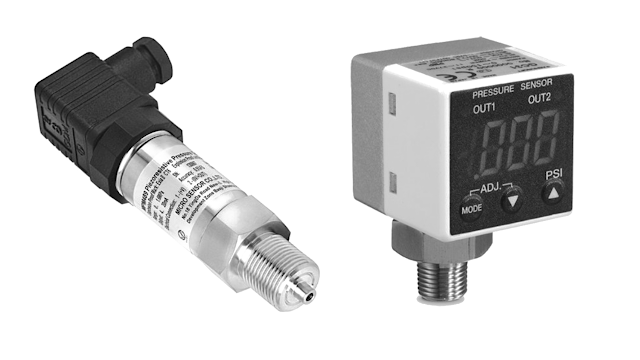Pressure Sensor
Pressure Sensor
A pressure sensor is a device for pressure measurement of gases or liquids. Pressure is an expression of the force required to stop a fluid from expanding, and is usually stated in terms of force per unit area. A pressure sensor usually acts as a transducer; it generates a signal as a function of the pressure imposed. For the purposes of this article, such a signal is electrical.
Pressure sensors are used for control and monitoring in thousands of everyday applications. Pressure sensors can also be used to indirectly measure other variables such as fluid/gas flow, speed, water level, and altitude. Pressure sensors can alternatively be called pressure transducers, pressure transmitters, pressure senders, pressure indicators, piezometers and manometers, among other names.
Working principle of a pressure sensor?
A pressure sensor works by converting pressure into an analogue electrical signal.
The demand for pressure measuring instruments increased during the steam age. When pressure sensing technologies were first manufactured they were mechanical and used Bourdon tube gauges to move a needle and give a visual indication of pressure. Nowadays we measure pressure electronically using pressure transducers and pressure switches.
Two Main Types of Pressure Sensors
Capacitive Sensors
Work based on measurement of capacitance from two parallel plates.
C = εA/d , A = area of plates d = distance between.
This implies that the response of a capacitive sensor is inherently non-linear. Worsened by diaphragm deflection.
Must use external processor to compensate for non-linearity
Piezoresistive Sensors
Work based on the piezoresistive properties of silicon and other materials.
Piezoresistivity is a response to stress.
Some piezoresistive materials are Si, Ge, metals.
In semiconductors, piezoresistivity is caused by 2 factors: geometry deformation and resistivity changes.
Types of pressure measurements
Absolute pressure sensor
This sensor measures the pressure relative to perfect vacuum. Absolute pressure sensors are used in applications where a constant reference is required, like for example, high-performance industrial applications such as monitoring vacuum pumps, liquid pressure measurement, industrial packaging, industrial process control and aviation inspection.
Gauge pressure sensor
This sensor measures the pressure relative to atmospheric pressure. A tire pressure gauge is an example of gauge pressure measurement; when it indicates zero, then the pressure it is measuring is the same as the ambient pressure. Most sensors for measuring up to 50 bar are manufactured in this way, since otherwise the atmospheric pressure fluctuation (weather) is reflected as an error in the measurement result.
Vacuum pressure sensor
This term can cause confusion. It may be used to describe a sensor that measures pressures below atmospheric pressure, showing the difference between that low pressure and atmospheric pressure, but it may also be used to describe a sensor that measures absolute pressure relative to a vacuum.
Differential pressure sensor
This sensor measures the difference between two pressures, one connected to each side of the sensor. Differential pressure sensors are used to measure many properties, such as pressure drops across oil filters or air filters, fluid levels (by comparing the pressure above and below the liquid) or flow rates (by measuring the change in pressure across a restriction). Technically speaking, most pressure sensors are really differential pressure sensors; for example a gauge pressure sensor is merely a differential pressure sensor in which one side is open to the ambient atmosphere.
Sealed pressure sensor
This sensor is similar to a gauge pressure sensor except that it measures pressure relative to some fixed pressure rather than the ambient atmospheric pressure (which varies according to the location and the weather).
What are pressure sensors used for?
Pressure sensors are used in a range of industries, including the automotive industry, Biomedical Instrumentation, aviation and the marine industry, to name a few.
Pressure sensor specifications
Pressure sensors are typically sized and specified by several common parameters which are shown below. Note that the specifications for these devices may vary from manufacturer to manufacturer and note as well that the specifications can be different depending on the specific type of pressure sensor being sourced. Having a basic understanding of these specifications will make the process of sourcing or specifying one of these sensors easier to accomplish.
Sensor type
Operating pressure range
Provides the range of pressures over which the sensor can operate and generate a signal output.
Maximum pressure
The absolute maximum value of pressure in which the device can reliably function without damaging the sensor. Exceeding the maximum pressure can result in device failure or inaccurate signal output.
Full scale
Is the difference between the maximum pressure that the sensor can measure and zero pressure.
Output type
Describes the general nature of the output signal characteristics from the pressure sensor. Examples include analog current, analog voltage, frequency, or other formats.
Output level
The range of output, such as 0-25mV, associated with the pressure sensor over its range of operation. For electrical signal outputs, this will usually be a millivolt or Volt rage, or a current output range in milliamps.
Accuracy
A measure of the deviation in measurement between the pressure level as defined by the sensor output versus the true value of pressure. Accuracy is often expressed as a +/- range of pressure unit (such as psi or millibars) or as a +/- percentage error. Accuracy of pressure sensors is usually defined against a best fit straight line of datapoints for signal output values against various applied pressure readings.
Resolution
Represents the smallest difference in the output signal that can be distinguished by the sensor.
Drift
A measure of the gradual change in the calibrated state of the sensor over time.
Supply voltage
The magnitude of the voltage source needed for powering the pressure sensor, measured in volts, most typically expressed as a range of input voltage that is acceptable.
Operating temperature range
The temperature extremes (high and low) over which the sensor is designed to operate reliably and provide an output signal.
Application
- Pressure sensing
- Altitude sensing
- Flow sensing
- Level / depth sensing
- Leak testing

Comments
Post a Comment